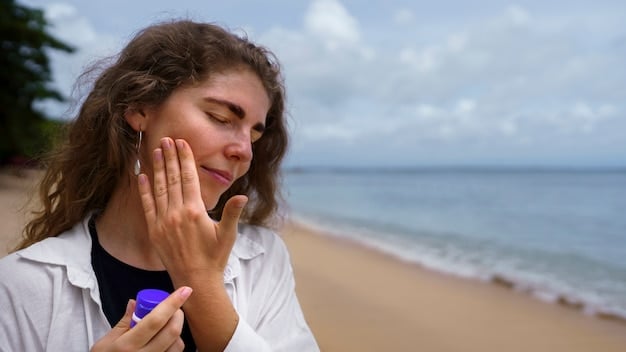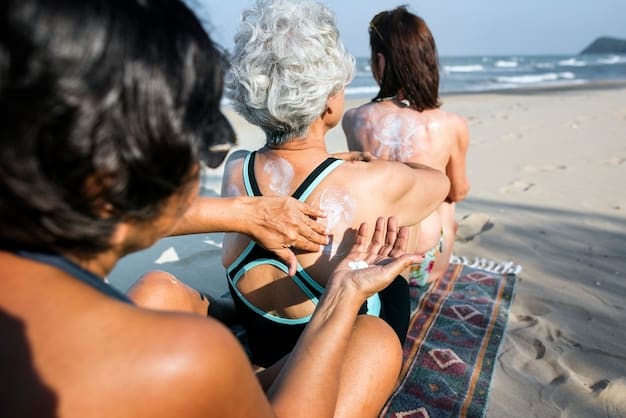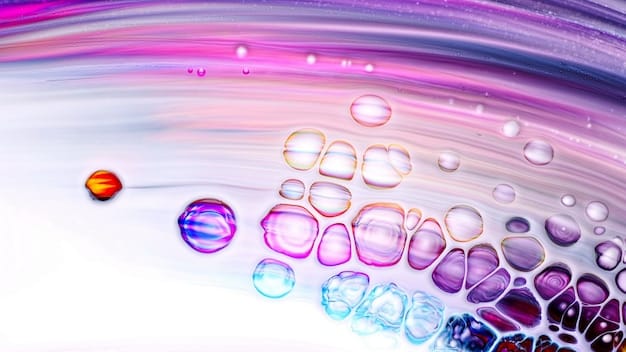Protect Your Skin: Ultimate Sunscreen & Safety Guide 2025

The ultimate guide to sun safety and sunscreen in 2025 emphasizes strategic sun protection beyond mere SPF, highlighting advancements in formulations, personalized UV defense, and holistic skin health practices to mitigate UV damage and reduce skin cancer risk globally.
In an era where environmental awareness and personal well-being converge, understanding how to Protect Your Skin: The Ultimate Guide to Sunscreen and Sun Safety in 2025 is more crucial than ever. This comprehensive guide delves into cutting-edge advancements, practical strategies, and essential knowledge to safeguard your skin against the sun’s potent rays, ensuring a healthier future for your largest organ.
Understanding the Sun’s Impact on Your Skin
The sun, while vital for life, emits various forms of ultraviolet (UV) radiation—UVA, UVB, and UVC—each with distinct impacts on human skin. UVC rays are largely absorbed by the ozone layer, posing minimal threat. However, UVA and UVB rays penetrate the atmosphere and reach our skin, carrying the potential for significant damage. Understanding these differences and their cumulative effects is the first step in effective sun protection.
UVA rays, constituting about 95% of the UV radiation reaching Earth, penetrate deeply into the skin’s dermis. They are primarily responsible for premature aging, including wrinkles, fine lines, and age spots, and play a significant role in the development of skin cancers. These rays are consistent throughout the year, even on cloudy days, and can penetrate glass, meaning you’re exposed indoors near windows or while driving.
The Distinction Between UVA and UVB Rays
UVB rays, while less prevalent, are more intense and are the primary cause of sunburn. They are largely responsible for DNA damage in skin cells, which directly contributes to the vast majority of skin cancers, including melanoma, the most dangerous form. UVB intensity varies by season, time of day, and geographic location, peaking in summer months and at higher altitudes.
- UVA: Deeper penetration, linked to aging and long-term DNA damage.
- UVB: Surface level, causes sunburn and direct DNA damage leading to cancer.
- Year-Round Risk: Both UVA and UVB are present year-round, necessitating daily protection.
Chronic exposure to both UVA and UVB leads to a range of skin issues beyond immediate sunburn. This includes photoaging—a term encompassing sunspots, leathery skin, and broken capillaries—and immune system suppression, which can reduce the body’s ability to fight off infections and diseases. Most critically, this cumulative damage significantly increases the risk of all types of skin cancer.
Recognizing the pervasive nature of UV radiation and its broad spectrum of harmful effects underscores the importance of a multifaceted approach to sun safety. It’s not just about avoiding sunburns; it’s about protecting against invisible damage that accumulates over a lifetime, impacting both cosmetic appearance and overall health.
Choosing the Right Sunscreen in 2025: What’s New?
The sunscreen landscape is continuously evolving, with 2025 ushering in new formulations and expanded scientific understanding. Selecting the appropriate sunscreen is no longer a simple matter of picking the highest SPF; it involves understanding ingredient types, broad-spectrum protection, water resistance, and how these factors align with your lifestyle and skin type. The focus has shifted towards comprehensive protection that considers environmental impact and individual needs.
Mineral sunscreens, containing zinc oxide and titanium dioxide, remain a cornerstone for broad-spectrum protection. These physical blockers sit on the skin’s surface, deflecting UV rays. Advances in nanotechnology have significantly improved their cosmetic elegance, reducing the white cast often associated with older formulations, making them more appealing for daily use.
Chemical vs. Mineral: The Persistent Debate
Chemical sunscreens, which absorb UV radiation through a chemical reaction on the skin, continue to offer diverse formulations. Ingredients like avobenzone, oxybenzone, and octinoxate are common. While effective, ongoing research is refining our understanding of their absorption rates and environmental impact, leading to a demand for newer, more stable filters with improved safety profiles. Brands are increasingly launching products free of oxybenzone and octinoxate due to environmental concerns, particularly regarding coral reefs.
- Mineral Sunscreens: Zinc Oxide, Titanium Dioxide – reflect UV, suitable for sensitive skin.
- Chemical Sunscreens: Absorb UV – often lighter textures, some newer filters offer enhanced stability.
- Hybrid Formulations: Combining both types for optimized protection and cosmetic feel.
SPF (Sun Protection Factor) indicates a sunscreen’s ability to protect against UVB rays. An SPF of 30 blocks approximately 97% of UVB rays, while SPF 50 blocks about 98%. The difference is marginal beyond SPF 30, but opting for at least SPF 30 with “broad-spectrum” protection is essential. Broad-spectrum indicates defense against both UVA and UVB rays, crucial for comprehensive protection against aging and cancer-causing damage.
Water resistance ratings, typically 40 or 80 minutes, indicate how long a sunscreen maintains its SPF during swimming or sweating. This is a critical factor for active individuals or those spending time outdoors, as reapplication becomes even more vital after water exposure. Look for labels clearly stating “water resistant (40 minutes)” or “water resistant (80 minutes).”
Application Best Practices: Maximizing Your Sunscreen’s Efficacy
Even the best sunscreen is ineffective if not applied correctly. Many people underestimate the amount needed, the frequency of reapplication, and the areas that require attention. Proper application is a non-negotiable step in building a robust defense against UV radiation, significantly impacting the product’s listed SPF and broad-spectrum benefits.
The general recommendation is to apply approximately two milligrams of sunscreen per square centimeter of skin. For most adults, this translates to about one ounce—a shot glass full—for the entire body, and a nickel-sized dollop for the face. Applying less reduces the effective SPF, leaving skin vulnerable to damage. It’s better to over-apply than under-apply.
The Golden Rules of Reapplication
Sunscreen should be applied 15-30 minutes before sun exposure to allow it to bind to the skin. This is especially true for chemical sunscreens, which need time to fully activate. For mineral sunscreens, the barrier protection is immediate upon application, but allowing it to settle can improve adherence.
- Generous Application: Use enough to cover all exposed skin adequately.
- Pre-Exposure Application: Apply 15-30 minutes before stepping into the sun.
- Frequent Reapplication: Every two hours, or immediately after swimming or excessive sweating.
Reapplication is arguably the most critical step. Sunscreen’s effectiveness diminishes over time due to sweating, swimming, towel drying, and simple degradation by UV light. Reapply every two hours, or more frequently if you’re swimming or sweating heavily. Don’t forget often-missed areas like the ears, neck, scalp (especially if thinning hair), tops of feet, and lips. Sunscreen sticks and lip balms with SPF are excellent for these delicate areas.
Consider sun-protective clothing as an important adjunct to sunscreen, especially for prolonged outdoor activities. Fabrics with a UPF (Ultraviolet Protection Factor) rating offer built-in sun protection, reducing the amount of skin that needs direct sunscreen application. This layered approach provides superior defense and is often more comfortable for extended periods in the sun.

Beyond Sunscreen: Comprehensive Sun Safety Strategies
While sunscreen is a vital tool, it’s part of a larger sun safety arsenal. Relying solely on sunscreen can create a false sense of security, leading to prolonged exposure. A holistic approach includes seeking shade, wearing protective clothing, and avoiding peak sun hours, collectively offering a more robust defense against harmful UV radiation.
Seeking shade is perhaps the simplest yet most effective strategy. Whether it’s under a tree, an umbrella, or a pop-up canopy, shade significantly reduces direct sun exposure. Plan outdoor activities during the early morning or late afternoon when the sun’s rays are less intense. Between 10 a.m. and 4 p.m. are generally considered peak UV hours in most regions, when the sun is highest in the sky.
The Role of Sun-Protective Apparel and Accessories
Sun-protective clothing, distinct from regular apparel, is specifically designed to block UV radiation. Look for garments with a UPF label, indicating their effectiveness. A UPF of 30 offers good protection, while UPF 50 provides excellent blocking. These fabrics are often tightly woven or chemically treated to enhance their UV-blocking capabilities, offering consistent protection without the need for reapplication.
- Seek Shade: Especially during peak UV hours (10 a.m. – 4 p.m.).
- Wear UPF Clothing: Offers consistent, physical UV barrier.
- Broad-Brimmed Hat: Protects face, neck, and ears.
- UV-Blocking Sunglasses: Safeguard eyes and delicate surrounding skin.
A broad-brimmed hat is crucial for protecting the face, scalp, ears, and neck—areas particularly susceptible to sun damage and skin cancer. Choose hats with a brim of at least three inches all the way around. Baseball caps, while offering some protection for the face, leave the ears and neck exposed.
Sunglasses that block 99-100% of both UVA and UVB rays are essential for eye health. Prolonged sun exposure can lead to cataracts, macular degeneration, and other eye conditions. Look for labels that explicitly state “UV400” or “100% UV protection.” Wraparound styles offer additional protection from peripheral light.
In addition to these external measures, be mindful of reflective surfaces like water, sand, and snow, which can intensify UV exposure. Even on cloudy days, UV rays can penetrate cloud cover, making consistent sun safety practices necessary regardless of the weather. Integrating these strategies into your daily routine provides comprehensive, multi-layered protection.
Common Sunscreen Myths Debunked for 2025
Despite widespread awareness campaigns, several persistent myths about sunscreen continue to circulate, leading to inadequate protection and increased risk of sun damage. Dispelling these misconceptions with up-to-date information is crucial for informed sun safety practices, especially as we approach 2025 with an even greater emphasis on preventative health.
One prevalent myth is that high SPF numbers offer significantly more protection. While SPF 50 blocks slightly more UVB rays than SPF 30 (98% vs. 97%), the difference is minimal. The key is consistent, generous application and reapplication, not merely opting for the highest number. Extremely high SPFs can also lead to a false sense of security, encouraging longer sun exposure.
Addressing Misconceptions About Skin Type and Sun Exposure
Another common misconception is that people with darker skin tones don’t need sunscreen. While individuals with more melanin have a natural, albeit limited, level of protection, they are still susceptible to sun damage, premature aging, and all forms of skin cancer. Skin cancer in people of color is often diagnosed at later, more dangerous stages, making consistent sun protection equally vital for all skin types.
- Myth: High SPF means complete protection. Fact: SPF 30 is sufficient; reapplication matters more.
- Myth: Dark skin doesn’t need sunscreen. Fact: All skin tones are vulnerable to sun damage and skin cancer.
- Myth: Using sunscreen prevents Vitamin D synthesis. Fact: Sunscreens reduce, but do not block, Vitamin D production.
Some believe that sunscreen completely blocks Vitamin D synthesis, leading to deficiencies. While sunscreen does reduce the skin’s ability to produce Vitamin D, studies show that regular sunscreen users do not typically have lower Vitamin D levels than non-users. Brief, unprotected sun exposure (5-15 minutes, 2-3 times a week, depending on location and skin type) is often sufficient, or Vitamin D can be obtained from diet and supplements, providing a safer alternative to excessive sun exposure.
The idea that waterproof sunscreen lasts all day is also misleading. “Water resistant” sunscreens are tested to maintain their SPF for either 40 or 80 minutes while swimming or sweating. After this time, or after towel drying, reapplication is necessary. No sunscreen is truly “waterproof” or offers all-day protection without reapplication, highlighting the importance of understanding product labels.
Finally, believing that you only need sunscreen on sunny days is a dangerous myth. Up to 80% of the sun’s UV rays can penetrate clouds. UV radiation is present year-round, even on overcast days and in winter. Incorporating daily sunscreen application into your routine, regardless of weather or season, is fundamental to effective sun protection.
Advanced Sun Protection Technologies and Future Outlook
The field of sun protection is constantly innovating, driven by scientific research and growing consumer demand for more effective, sustainable, and user-friendly solutions. As we look towards 2025 and beyond, new technologies and approaches are set to redefine how we protect our skin from the sun, moving beyond traditional creams and lotions.
One emerging area is “smart” sun protective clothing and accessories. These innovations may include fabrics that change color to indicate UV intensity or integrated sensors that monitor sun exposure and alert users when it’s time to reapply sunscreen or seek shade. Such technologies aim to provide real-time, personalized guidance for sun safety.
Beyond UV: Protection Against Visible Light and Blue Light
Beyond traditional UV filters, research is increasingly focusing on protection against other spectrums of light, particularly visible light and high-energy visible (HEV) light, also known as blue light. These wavelengths, emitted by the sun and electronic devices, are now understood to contribute to hyperpigmentation and photoaging. Ingredient innovations like iron oxides and specific antioxidants are being incorporated into sunscreens to offer broader protection.
- DNA Repair Enzymes: Topical applications that assist in repairing sun-damaged DNA.
- Antioxidant Boosters: Formulations with vitamins C and E, ferulic acid to neutralize free radicals.
- Oral Photoprotection: Dietary supplements (e.g., Polypodium leucotomos extract) to support skin’s natural defenses.
The concept of “oral photoprotection” is gaining traction. While not a replacement for topical sunscreen, certain dietary supplements, such as those containing Polypodium leucotomos extract, have shown promise in enhancing the skin’s natural defenses against UV damage and reducing the severity of sunburn. These supplements work from the inside out to provide an additional layer of protection.
Biotechnology is also playing a significant role, leading to the development of sunscreens with integrated DNA repair enzymes. These topical agents are designed to help the skin’s natural repair mechanisms undo some of the damage caused by UV exposure, potentially mitigating the long-term effects. While still an evolving field, this represents a proactive approach to sun protection.
Furthermore, sustainability is a growing concern, impacting sunscreen formulation. The industry is moving towards reef-safe ingredients, biodegradable packaging, and more eco-friendly manufacturing processes. Consumers can expect to see more transparent labeling regarding environmental impact and ethically sourced ingredients as companies respond to global environmental awareness.

The Long-Term Benefits of Consistent Sun Protection
Embracing a lifestyle of consistent sun protection offers profound and lasting benefits that extend far beyond avoiding a painful sunburn. These advantages encompass improved skin health, reduced risk of serious diseases, and maintenance of a youthful appearance, making diligent sun safety a true investment in future well-being.
The most significant long-term benefit is the drastic reduction in the risk of skin cancer. Basal cell carcinoma, squamous cell carcinoma, and melanoma are directly linked to UV exposure. By consistently protecting your skin, you significantly lower your chances of developing these potentially deadly diseases, often caught early through vigilance and regular dermatologist check-ups.
Preserving Skin Integrity and Youthful Appearance
Beyond cancer prevention, consistent sun protection is the most effective anti-aging strategy available. Photoaging—premature aging caused by sun exposure—manifests as wrinkles, fine lines, age spots (solar lentigines), leathery texture, and broken capillaries. By minimizing UV damage, you preserve collagen and elastin, the proteins that give skin its firmness and elasticity, thus maintaining a smoother, more youthful complexion decades longer.
- Reduced Cancer Risk: Significantly lowers incidence of melanoma and other skin cancers.
- Anti-Aging: Prevents wrinkles, fine lines, and sunspots for healthier, younger-looking skin.
- Even Skin Tone: Minimizes hyperpigmentation and discoloration.
- Immune System Support: Reduces UV-induced suppression of the skin’s immune defenses.
Sun protection also contributes to a more even skin tone. UV exposure is a primary trigger for hyperpigmentation, including melasma and post-inflammatory hyperpigmentation. Consistent use of sunscreen helps prevent the overproduction of melanin, leading to clearer, more uniform skin. Existing dark spots can also be prevented from worsening with diligent protection.
Moreover, sun protection helps maintain the skin’s immune function. Prolonged UV exposure can suppress the skin’s local immune system, making it more vulnerable to infections and reducing its ability to detect and fight off cancerous changes. Safeguarding your skin keeps this critical defense mechanism robust and effective.
Ultimately, prioritizing sun safety is a commitment to overall health. It’s about protecting your skin’s vital functions, preserving its appearance, and, most importantly, safeguarding your health against the silent and cumulative damage of UV radiation. The habits formed today will pay dividends in skin vitality and freedom from disease for years to come.
| Key Point | Brief Description |
|---|---|
| 🧴 Broad-Spectrum SPF 30+ | Opt for sunscreens protecting against UVA/UVB rays with at least SPF 30, reapplying generously every 2 hours. |
| 📅 Daily Application | Sunscreen is essential daily, regardless of weather or indoor/outdoor activity, due to pervasive UV exposure. |
| 🛡️ Layered Protection | Combine sunscreen with shade, UPF clothing, hats, and UV-blocking sunglasses for comprehensive defense. |
| 🔬 Future Innovations | Look for advanced formulas with blue light protection, DNA repair enzymes, and sustainable ingredients. |
Frequently Asked Questions About Sun Protection
▼
UVA rays penetrate deeper into the skin, contributing primarily to aging (wrinkles, age spots) and long-term DNA damage. UVB rays are responsible for sunburn and are the primary cause of most skin cancers due to direct DNA damage. Both contribute to skin cancer risk, making broad-spectrum protection vital.
▼
For adults, a general guideline is to apply about one ounce (a shot glass full) for the entire body and a nickel-sized amount for the face. Applying generously ensures you achieve the product’s stated SPF, providing adequate coverage and protection.
▼
Yes, UVA rays can penetrate glass and clouds, exposing you to skin damage even indoors near windows or on overcast days. Daily sunscreen application is recommended to protect against constant, cumulative UV exposure, regardless of weather or location.
▼
“Broad-spectrum” sunscreen protects against both UVA and UVB rays. This is crucial because UVA contributes to aging and long-term damage, while UVB causes sunburn and directly leads to skin cancer. Comprehensive protection ensures defense against both types of harmful radiation.
▼
Yes, emerging advancements include “smart” UV-sensing apparel, sunscreens offering blue light protection, and oral photoprotection supplements. Biotechnology is also developing formulations with DNA repair enzymes, promising more comprehensive and internally supportive skin defense strategies.
Conclusion
As we navigate toward 2025, the imperative to protect our skin from the sun’s potent rays has never been clearer. This comprehensive guide, “Protect Your Skin: The Ultimate Guide to Sunscreen and Sun Safety in 2025,” underscores that effective sun defense extends far beyond a single product. It’s a strategic, multi-layered commitment involving informed sunscreen choices, meticulous application, and smart lifestyle practices. By understanding the nuances of UV radiation, embracing cutting-edge protective technologies, and debunking persistent myths, we empower ourselves to safeguard skin health proactively. The long-term benefits—reduced cancer risk, preserved youthful appearance, and enhanced skin vitality—make diligent sun safety an invaluable investment in our well-being for decades to come, ensuring our largest organ remains healthy and resilient.





